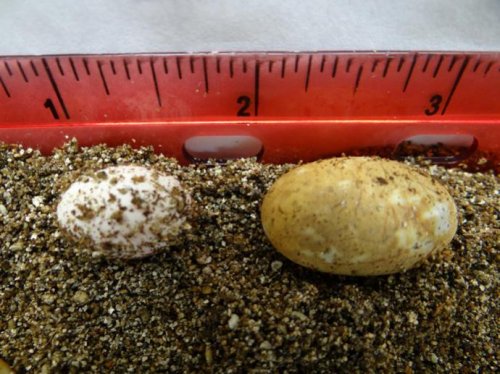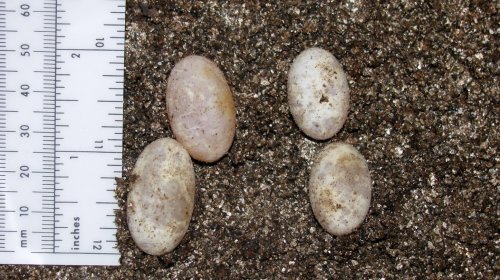pamnsam94
Established Member
The female quad I've been expecting to lay for a while now, started laying today. Unfortunately, I didn't write down when I last saw her breed with the male I bred her to (the male in my avatar with 5 horns), but I knew she was past due. I just didn't know how much so. The mother of the fourteen 21 week old babies I'm raising (bred to a different male), became gravid again, and on 9/10/12, she laid 10 more eggs, 4 of which have gone bad already. I pretty much figured a really small one wasn't good and suspected a couple of other as being bad also. In any case, I definetly thought the female that is laying today would lay way before the other female, especially since she was so much fatter.
The female that started laying today did not choose the best site to dig. The other female laid in the area with the deepest substrate both times. Why this female (I guess I need to name my chams ) would choose a shallow spot is anyone's guess but she is busy trying to cover up the eggs. Since she was not able to dig a tunnel in the area she is working (not deep enough), I was able to quickly reach in and grab 5 of the eggs behind her (she was pushing her head down as far as she could) without disturbing her. I just had to post this.
) would choose a shallow spot is anyone's guess but she is busy trying to cover up the eggs. Since she was not able to dig a tunnel in the area she is working (not deep enough), I was able to quickly reach in and grab 5 of the eggs behind her (she was pushing her head down as far as she could) without disturbing her. I just had to post this.
These are the biggest quad eggs I have ever seen, much bigger than the eggs I've seen go full term! She obviously retained them longer than she should have, but I'm wondering if they have any chance at all. I'm just fortunate I guess that the female didn't become egg bound (I've never experienced or heard of a quad becoming egg bound). It's amazing she was even able to pass these. Two of the 5 I took out though are oozing. I don't know if them bursting is what finally triggered her to lay, but I'm hoping that any fluid that leaked inside of her won't cause any problems.
Although I'm mostly concerned about her now, I am wondering many things about the eggs themselves. They all seem to be fully calcified (no yellow areas). They all have a greater amount of brown coloration than I've seen before. However, the 14 eggs that hatched from the other female had the same shade of brown (though less of it) but those eggs were more streaked/spotted with brown. I'd like to know if anyone knows what the brown coloration is caused by. I've had all white eggs and white eggs with brown spots hatch so the coloration alone is not my main concern.
I know there has to be a limit as to how much an egg can expand before bursting, but since some of the eggs are not leaking, I wonder if they might have a chance. I suspect not, but time will tell. Has anyone else ever seen a quad egg this big? All the eggs from this clutch (I think there are at least 3 more) are equally huge. Again, I'm amazed. I just wish she would have laid sooner.
Also, I feel like I should know this, but I'm wondering if embryogenesis starts strictly by the age of the egg (how long it has been developing) or if there is a chemical cue of some kind that triggers development after the eggs are laid. I know that eggs of many species (not quads) have a diapause period where there is no development. Environmental factors supposedly triggers development. In other species I've bred, like T. johnstoni, I was able to candle the eggs soon after laying and was able to detect the pinkish coloration indicative of vascularization and could even sometimes see vessels. Quads have a shorter incubation period than many other species (around 5 months usually). I'm wondering if these eggs are fertile, and since they were obviously retained way too long, if embryogenesis already might have occurred to a greater extent than normal. If so, might the process of the female simply moving around in her day to day activities or even the process of her just laying the eggs be, in essence, similar to turning the eggs (thereby destroying them) part way through development? Am I making any sense? In otherwords, how far can embryogenesis occur in the mother before she is able to lay eggs and the eggs still be viable?
I have one last question. What specifically happens when an egg is rotated that is fatal to the embryo and how does that compare to ovoviviparous species which can hang upside down without harming the embryos they are carrying? I've never read about what is actually occuring that causes fatalities in one instance but is completely harmless in the other. Thanks.
Perry
The female that started laying today did not choose the best site to dig. The other female laid in the area with the deepest substrate both times. Why this female (I guess I need to name my chams
These are the biggest quad eggs I have ever seen, much bigger than the eggs I've seen go full term! She obviously retained them longer than she should have, but I'm wondering if they have any chance at all. I'm just fortunate I guess that the female didn't become egg bound (I've never experienced or heard of a quad becoming egg bound). It's amazing she was even able to pass these. Two of the 5 I took out though are oozing. I don't know if them bursting is what finally triggered her to lay, but I'm hoping that any fluid that leaked inside of her won't cause any problems.
Although I'm mostly concerned about her now, I am wondering many things about the eggs themselves. They all seem to be fully calcified (no yellow areas). They all have a greater amount of brown coloration than I've seen before. However, the 14 eggs that hatched from the other female had the same shade of brown (though less of it) but those eggs were more streaked/spotted with brown. I'd like to know if anyone knows what the brown coloration is caused by. I've had all white eggs and white eggs with brown spots hatch so the coloration alone is not my main concern.
I know there has to be a limit as to how much an egg can expand before bursting, but since some of the eggs are not leaking, I wonder if they might have a chance. I suspect not, but time will tell. Has anyone else ever seen a quad egg this big? All the eggs from this clutch (I think there are at least 3 more) are equally huge. Again, I'm amazed. I just wish she would have laid sooner.
Also, I feel like I should know this, but I'm wondering if embryogenesis starts strictly by the age of the egg (how long it has been developing) or if there is a chemical cue of some kind that triggers development after the eggs are laid. I know that eggs of many species (not quads) have a diapause period where there is no development. Environmental factors supposedly triggers development. In other species I've bred, like T. johnstoni, I was able to candle the eggs soon after laying and was able to detect the pinkish coloration indicative of vascularization and could even sometimes see vessels. Quads have a shorter incubation period than many other species (around 5 months usually). I'm wondering if these eggs are fertile, and since they were obviously retained way too long, if embryogenesis already might have occurred to a greater extent than normal. If so, might the process of the female simply moving around in her day to day activities or even the process of her just laying the eggs be, in essence, similar to turning the eggs (thereby destroying them) part way through development? Am I making any sense? In otherwords, how far can embryogenesis occur in the mother before she is able to lay eggs and the eggs still be viable?
I have one last question. What specifically happens when an egg is rotated that is fatal to the embryo and how does that compare to ovoviviparous species which can hang upside down without harming the embryos they are carrying? I've never read about what is actually occuring that causes fatalities in one instance but is completely harmless in the other. Thanks.
Perry








